Development of Drift-Reducing Spouts For Vineyard Pneumatic Sprayers: Measurement of Droplet Size Spectra Generated and Their Classification
Abstract
:Featured Application
Abstract
1. Introduction
2. Materials and Methods
2.1. Trial Location and Spraying Equipment
2.2. Droplet Size Spectra and Airflow Speed Measurements
2.3. Spray Parameters, Experimental Design and Settings Used During Trials
2.4. Data Analysis
3. Results and Discussion
3.1. Airflow Speed Drop Along the Spouts
3.2. Droplets Size Spectra Measured
3.2.1. Cannon-Type Nozzle
3.2.2. Hand-Type Nozzle
3.3. Cumulative Sprayed Volume Curves and Their Classification According to ASABE S572.1
3.4. Droplet Homogeneity
3.5. Droplet Driftability
4. Conclusions
Author Contributions
Funding
Acknowledgments
Conflicts of Interest
Abbreviations
| AS | Air speed |
| AP | Alternative insertion position of the liquid hose in the spout |
| CP | Conventional insertion position of the liquid hose in the spout |
| D10 | Diameter for which a volume fraction of 10% is made up of drops with diameters smaller than this value (expressed in µm) |
| D50 | Diameter for which a volume fraction of 50% is made up of drops with diameters smaller than this value (expressed in µm) |
| D90 | Diameter for which a volume fraction of 90% is made up of drops with diameters smaller than this value (expressed in µm) |
| HP | Liquid hose position |
| LFR | Liquid flow rate in the spraying circuit |
| OP | Insertion position of the liquid hose out of the spout |
| RSF | Relative SPAN factor, a measure of the droplet homogeneity in the spray population (dimensionless) |
| V100 | Spray liquid fraction generated with droplets smaller than 100 µm (expressed in %) |
| VMD | Volumetric median diameter, equivalent to D50 |
| XP | Insertion position of the liquid hose at the extreme distance out of the spout |
References
- International Organization of Vine and Wine. OIV Statistical Report on World Vitiviniculture. 2018. Available online: http://www.oiv.int/public/medias/6371/oiv-statistical-report-on-world-vitiviniculture-2018.pdf (accessed on 7 September 2020).
- Goodell, P.B. Fifty years of integrated control concept: The role of landscape ecology in IPM in San Joaquin valley cotton. Pest Manag. Sci. 2009, 65, 1293–1297. [Google Scholar] [CrossRef] [PubMed]
- Gil, E.; Escolà, A. Design of a decision support method to determine volume rate for vineyard spraying. Appl. Eng. Agric. 2009, 25, 145–152. [Google Scholar] [CrossRef]
- EC. Directive 2009/128/EC of the European Parliament and the Council of 21 October 2009 Establishing a Framework for Community Action to Achieve the Sustainable use of Pesticides. Off. J. Eur. Union L 2009, 309, 71–86. [Google Scholar]
- Cerruto, E.; Manetto, G.; Longo, D.; Failla, S.; Papa, R. A model to estimate the spray deposit by simulated water sensitive papers. Crop. Prot. 2019, 124, 104861. [Google Scholar] [CrossRef]
- Cross, J.V.; Walklate, P.J.; Murray, R.A.; Richardson, G.M. Spray deposits and losses in different sized apple trees from an axial fan orchard sprayer: 1. Effects of spray liquid flow rate. Crop. Prot. 2001, 20, 13–30. [Google Scholar] [CrossRef]
- Cross, J.V.; Walklate, P.J.; Murray, R.A.; Richardson, G.M. Spray deposits and losses in different sized apple trees from an axial fan orchard sprayer: 2. Effects of spray quality. Crop. Prot. 2001, 20, 333–343. [Google Scholar] [CrossRef]
- Cross, J.V.; Walklate, P.; Murray, R.; Richardson, G. Spray deposits and losses in different sized apple trees from an axial fan orchard sprayer: 3. Effects of air volumetric flow rate. Crop. Prot. 2003, 22, 381–394. [Google Scholar] [CrossRef]
- Failla, S.; Romano, E.; Longo, D.; Bisaglia, C.; Schillaci, G. Effect of different axial fans configurations on airflow rate. In Innovative Biosystems Engineering for Sustainable Agriculture, Forestry and Food Production, Proceedings of the MID-TERM AIIA, Matera, Italy, 12–13 September; Coppola, A., Di Renzo, G., Altieri, G., D’Antonio, P., Eds.; Springer: Cham, Switzerland, 2020; Volume 67, pp. 691–699. [Google Scholar] [CrossRef]
- Hołownicki, R.; Doruchowski, G.; Świechowski, W.; Godyń, A.; Konopacki, P.J. Variable air assistance system for orchard sprayers; concept, design and preliminary testing. Biosyst. Eng. 2017, 163, 134–149. [Google Scholar] [CrossRef]
- Longo, D.; Manetto, G.; Papa, R.; Cerruto, E. Design and construction of a low-cost test bench for testing agricultural spray nozzles. Appl. Sci. 2020, 10, 5221. [Google Scholar] [CrossRef]
- Nuyttens, D.; Baetens, K.; de Schampheleire, M.; Sonck, B. Effect of nozzle type, size and pressure on spray droplet characteristics. Biosyst. Eng. 2007, 97, 333–345. [Google Scholar] [CrossRef]
- Salcedo, R.; Vallet, A.; Granell, R.; Garcerá, C.; Moltó, E.; Chueca, P. Eulerian–Lagrangian model of the behaviour of droplets produced by an air-assisted sprayer in a citrus orchard. Biosyst. Eng. 2017, 154, 76–91. [Google Scholar] [CrossRef]
- Świechowski, W.; Doruchowski, G.; Holownicki, R.; Godyn, A. Penetration of air within the apple tree canopy as affected by the air jet characteristics and travel velocity of the sprayer. Electron. J. Pol. Agric. Univ. 2004, 7, #03. [Google Scholar]
- Celen, I.H.; Arin, S.; Durgut, M.R. The effect of the air blast sprayer speed on the chemical distribution in vineyard. Pak. J. Biol. Sci. 2008, 11, 1472–1476. [Google Scholar] [CrossRef]
- Cerruto, E. Influence of airflow rate and forward speed on the spray deposit in vineyards. J. Agric. Eng. 2007, 1, 7–14. [Google Scholar]
- Duga, A.T.; Ruysen, K.; Dekeyser, D.; Nuyttens, D.; Bylemans, D.; Nicolaï, B.M.; Verboven, P. Spray deposition profiles in pome fruit trees: Effects of sprayer design, training system and tree canopy characteristics. Crop. Prot. 2015, 67, 200–213. [Google Scholar] [CrossRef]
- ISO. ISO22866:2005: Equipment for Crop Protection-Methods for Field Measurements of Spray Drift; International Organization for Standardization: Geneva, Switzerland, 2005; pp. 1–17. [Google Scholar]
- Arvidsson, T.; Bergström, L.; Kreuger, J. Spray drift as influenced by meteorological and technical factors. Pest Manag. Sci. 2011, 67, 586–598. [Google Scholar] [CrossRef]
- Garcerá, C.; Moltó, E.; Chueca, P. Spray pesticide applications in Mediterranean citrus orchards: Canopy deposition and off-target losses. Sci. Total Environ. 2017, 599, 1344–1362. [Google Scholar] [CrossRef]
- Gil, E.; Llorens, J.; Gallart, M.; Gil-Ribes, J.A.; Miranda-Fuentes, A. First attempts to obtain a reference drift curve for traditional olive grove’s plantations following ISO 22866. Sci. Total Environ. 2018, 627, 349–360. [Google Scholar] [CrossRef] [PubMed]
- Gil, E.; Llorens, J.; Llop, J.; Fàbregas, X.; Gallart, M. Use of a terrestrial LIDAR sensor for drift detection in vineyard spraying. Sensors 2013, 13, 516–534. [Google Scholar] [CrossRef] [Green Version]
- Grella, M.; Gallart, M.; Marucco, P.; Balsari, P.; Gil, E. Ground deposition and airborne spray drift assessment in vineyard and orchard: The influence of environmental variables and sprayer settings. Sustainability 2017, 9, 728. [Google Scholar] [CrossRef] [Green Version]
- Grella, M.; Marucco, P.; Balafoutis, A.T.; Balsari, P. Spray drift generated in vineyard during under-row weed control and suckering: Evaluation of direct and indirect drift-reducing techniques. Sustainability 2020, 12, 5068. [Google Scholar] [CrossRef]
- Grella, M.; Marucco, P.; Manzone, M.; Gallart, M.; Balsari, P. Effect of sprayer settings on spray drift during pesticide application in poplar plantations (Populus spp.). Sci. Total Environ. 2017, 578, 427–439. [Google Scholar] [CrossRef] [Green Version]
- Praat, J.P.; Maber, J.F.; Manktelow, D.W.L. The effect of canopy development and sprayer position on spray drift from a pipfruit orchard. N. Z. Plant Prot. 2000, 53, 241–247. [Google Scholar] [CrossRef]
- Salyani, M.; Farooq, M.; Sweeb, R.D. Spray deposition and mass balance in citrus orchard applications. Trans. ASABE 2007, 50, 1963–1969. [Google Scholar] [CrossRef]
- Felsot, A.S.; Unsworth, J.B.; Linders, J.B.H.J.; Roberts, G. Agrochemical spray drift; assessment and mitigation—A review. J. Environ. Sci. Health B 2011, 46, 1–23. [Google Scholar] [CrossRef]
- Balsari, P.; Marucco, P.; Tamagnone, M. A system to assess the mass balance of spray applied to tree crops. Trans. ASAE 2005, 48, 1689–1694. [Google Scholar] [CrossRef]
- Derksen, R.C.; Zhu, H.; Fox, R.D.; Brazee, R.D.; Krause, C.R. Coverage and drift produced by air induction and conventional hydraulic nozzles used for orchard applications. Trans. ASABE 2007, 50, 1493–1501. [Google Scholar] [CrossRef]
- Bonds, J.A.S.; Leggett, M. A Literature Review of Downwind Drift from Airblast Sprayers: Development of Standard Methodologies and a Drift Database. Trans. ASABE 2015, 58, 1471–1477. [Google Scholar]
- Fox, R.D.; Derksen, R.C.; Zhu, H.; Brazee, R.D.; Svensson, S.A. A history of air-blast sprayer development and future prospects. Trans. ASABE 2008, 51, 405–410. [Google Scholar] [CrossRef]
- Gil, Y.; Sinfort, C. Emission of pesticides to the air during sprayer application: A bibliographic review. Atmos. Environ. 2005, 39, 5183–5193. [Google Scholar] [CrossRef]
- Hewitt, A.J. Droplet size and agricultural spraying, part I: Atomization, spray transport, deposition, drift, and droplet size measurement techniques. At. Sprays 1997, 7, 235–244. [Google Scholar] [CrossRef]
- Lešnik, M.; Pintar, C.; Lobnik, A.; Kolar, M. Comparison of the effectiveness of standard and drift-reducing nozzles for control of some pests of apple. Crop. Prot. 2005, 24, 93–100. [Google Scholar] [CrossRef]
- Miranda-Fuentes, A.; Rodríguez-Lizana, A.; Cuenca, A.; González-Sánchez, J.; Blanco-Roldán, G.L.; Gil-Ribes, J.A. Improving plant protection product applications in traditional and intensive olive orchards through the development of new prototype air-assisted sprayers. Crop. Prot. 2017, 94, 44–58. [Google Scholar] [CrossRef]
- Rautmann, D.; Streloke, M.; Winkler, R. New basic drift values in the authorization procedure for plant protection products. Mitt. Biol. Bundesanst Forstwirtsch 2001, 383, 133–141. [Google Scholar]
- TOPPS-Prowadis Project. Best Management Practices to Reduce Spray Drift. 2014. Available online: http://www.topps-life.org/ (accessed on 7 September 2020).
- Melese, E.A.; Debaer, C.; Rutten, N.; Vercammen, J.; Delele, M.A.; Ramon, H.; Nicolaï, B.M.; Verboven, P. A new integrated CFD modelling approach towards air-assisted orchard spraying. Part I. Model development and effect of wind speed and direction on sprayer airflow. Comput. Electron. Agric. 2010, 71, 128–136. [Google Scholar]
- Herbst, A. A method to determine spray drift potential from nozzles and its link to buffer zone restrictions. In Proceedings of the ASAE Annual International Meeting, Sacramento, CA, USA, 28 July–1 August 2001. Paper number: 1-1047. [Google Scholar]
- Doruchowski, G.; Swiechowski, W.; Holownicki, R.; Godyn, A. Environmentally-Dependent Application System (EDAS) for safer spray application in fruit growing. J. Hortic. Sci. Biotechnol. 2009, 86, 107–112. [Google Scholar] [CrossRef]
- Hofman, V.; Solseng, E. Reducing Spray Drift; North Dakota State University NDSU Extension Service AE-1210; North Dakota State University NDSU Extension Service: Fargo, ND, USA, 2017. [Google Scholar]
- Van de Zande, J.C.; Holterman, H.J.; Wenneker, M. Nozzle classification for drift reduction in orchard spraying: Identification of drift reduction class threshold nozzles. Agric. Eng. Int. CIGR Ejournal 2008, 10, 1–12. [Google Scholar]
- Nuyttens, D.; de Schampheleire, M.; Verboven, P.; Brusselman, E.; Dekeyser, D. Droplet size and velocity characteristics of agricultural sprays. Trans. ASABE 2009, 52, 1471–1480. [Google Scholar] [CrossRef]
- Garcerá, C.; Román, C.; Moltó, E.; Abad, R.; Insa, J.A.; Torrent, X.; Planas, S.; Chueca, P. Comparison between standard and drift reducing nozzles for pesticide application in citrus: Part II. Effects on canopy spray distribution, control efficacy of Aonidiella aurantii (Maskell), beneficial parasitoids and pesticide residues on fruit. Crop. Prot. 2017, 94, 83–96. [Google Scholar] [CrossRef] [Green Version]
- Cawood, P.N.; Robinson, T.H.; Whittaker, S. An investigation of alternative application techniques for the control of blackgrass. In Proceedings of the Brighton Crop Protection Conference-Weeds, Brighton, UK, 20–23 November 1995; pp. 521–528. [Google Scholar]
- Doruchowski, G.; Swiechowski, W.; Masny, S.; Maciesiak, A.; Tartanus, M.; Bryk, H.; Hołownicki, R. Low-drift nozzles vs. standard nozzles for pesticide application in the biological efficacy trials of pesticides in apple pest and disease control. Sci. Total Environ. 2017, 575, 1239–1246. [Google Scholar] [CrossRef] [PubMed]
- Balsari, P.; Gil, E.; Marucco, P.; van de Zande, J.C.; Nuyttens, D.; Herbst, A.; Gallart, M. Field-crop-sprayer potential drift measured using test bench: Effects of boom height and nozzle type. Biosyst. Eng. 2017, 154, 3–13. [Google Scholar] [CrossRef] [Green Version]
- Codis, S.; Verges, A.; Auvergne, C.; Bonicel, J.F.; Diouloufet, G.; Cavalier, R.; Douzals, J.P.; Magnier, J.; Montegano, P.; Ribeyrolles, X.; et al. Optimization of early growth stage treatments of the vine: Experimentations on the artificial vine EvaSprayViti. Proceedings of SuproFruit, 13th Workshop on Spray Application Techniques in Fruit Growing, Lindau/Lake Constance, Germany, 15–18 July 2015; pp. 47–48. [Google Scholar]
- Porras Soriano, A.; Porras Soriano, M.L.; Porras Piedra, A.; Soriano Martìn, M.L. Comparison of the pesticide coverage achieved in a trellised vineyard by a prototype tunnel sprayer, a hydraulic sprayer, an air assisted sprayer and a pneumatic sprayer. Span. J. Agric. Res. 2005, 3, 175–181. [Google Scholar] [CrossRef] [Green Version]
- Marucco, P.; Balsari, P.; Grella, M.; Pugliese, M.; Eberle, D.; Gil, E.; Llop, J.; Fountas, S.; Mylonas, N.; Tsitsigiannis, D.; et al. OPTIMA EU project: Main goal and first results of inventory of current spray practices in vineyards and orchards. In Proceedings of the SuproFruit, 15th Workshop on Spray Application and Precision Technology in Fruit Growing, East Malling, UK, 16–18 July 2019; pp. 99–100. [Google Scholar]
- Grella, M.; Marucco, P.; Balsari, P. Evaluation of potential spray drift generated by different aypes of Airblast sprayers using an “ad hoc” test bench device. In Innovative Biosystems Engineering for Sustainable Agriculture, Forestry and Food Production, Proceedings of the MID-TERM AIIA, Matera, Italy, 12–13 September; Coppola, A., Di Renzo, G., Altieri, G., D’Antonio, P., Eds.; Springer: Cham, Switzerland, 2020; Volume 67, pp. 431–440. [Google Scholar] [CrossRef]
- Balsari, P.; Grella, M.; Marucco, P.; Matta, F.; Miranda-Fuentes, A. Assessing the influence of air speed and liquid flow rate on the droplet size and homogeneity in pneumatic spraying. Pest Manag. Sci. 2019, 75, 366–379. [Google Scholar] [CrossRef]
- Balsari, P.; Tamagnone, M.; Marucco, P.; Matta, F. How air liquid parameters affect droplet size: Experiences with different pneumatic nozzles. Asp. Appl. Biol. 2016, 132, 265–271. [Google Scholar]
- Miranda-Fuentes, A.; Marucco, P.; Gonzalez-Sanchez, E.J.; Gil, E.; Grella, M.; Balsari, P. Developing strategies to reduce spray drift in pneumatic spraying vineyards: Assessment of the parameters affecting droplet size in pneumatic spraying. Sci. Total Environ. 2018, 616–617, 805–815. [Google Scholar] [CrossRef] [Green Version]
- Byass, J.B.; Lake, J.R. Spray drift from a tractor-powered field sprayer. Pestic. Sci. 1977, 8, 117–126. [Google Scholar] [CrossRef]
- Grover, R.; Kerr, L.A.; Maybank, J.; Yoshida, K. Field measurements of droplets drift from ground sprayers. I. Sampling, analytical and data integration techniques. Can. J. Plant Sci. 1978, 58, 611–622. [Google Scholar] [CrossRef]
- Grella, M.; Miranda-Fuentes, A.; Marucco, P.; Balsari, P. Field assessment of a newly-designed pneumatic spout to contain spray drift in vineyards: Evaluation of canopy distribution and off-target losses. Pest. Manag. Sci. 2020. [Google Scholar] [CrossRef] [PubMed]
- Matthews, G.A.; Hislop, E.C. Application Technology for Crop Protection, 1st ed.; C.A.B. International: Wallingford, UK, 1993; p. 359. [Google Scholar]
- Wenneker, M.; van de Zande, J.C.; Stallinga, H.; Michielsen, J.M.P.G.; van Velde, P.; Nieuwenhuitzen, A.T. Emission reduction in orchards by improved spray deposition and increased spray drift reduction of multiple row sprayers. Asp. Appl. Biol. 2014, 122, 195–202. [Google Scholar]
- R Core Team. R: A Language and Environment for Statistical Computing; R Foundation for Statistical Computing: Vienna, Austria, 2019; Available online: https://www.R-project.org (accessed on 7 September 2020).
- IBM Corp. IBM SPSS Statistics for Windows; Version 25.0; IBM Corp: Armonk, NY, USA, 2017. [Google Scholar]
- American Society of Agricultural Engineers. ASABE S572.1 Spray Nozzle Classification by Droplet Spectra; American Society of Agricultural Engineers: St. Joseph, MI, USA, 2009; p. 4. [Google Scholar]
- Southcombe, E.S.E.; Miller, P.C.H.; Ganzelmeier, H.; van de Zande, J.C.; Miralles, A.; Hewitt, A.J. The international (BCPC) spray classification system including a drift potential factor. In Proceedings of the Brighton Crop Protection Conference-Weeds, Brighton, UK, 17–20 November 1997; pp. 371–380. [Google Scholar]

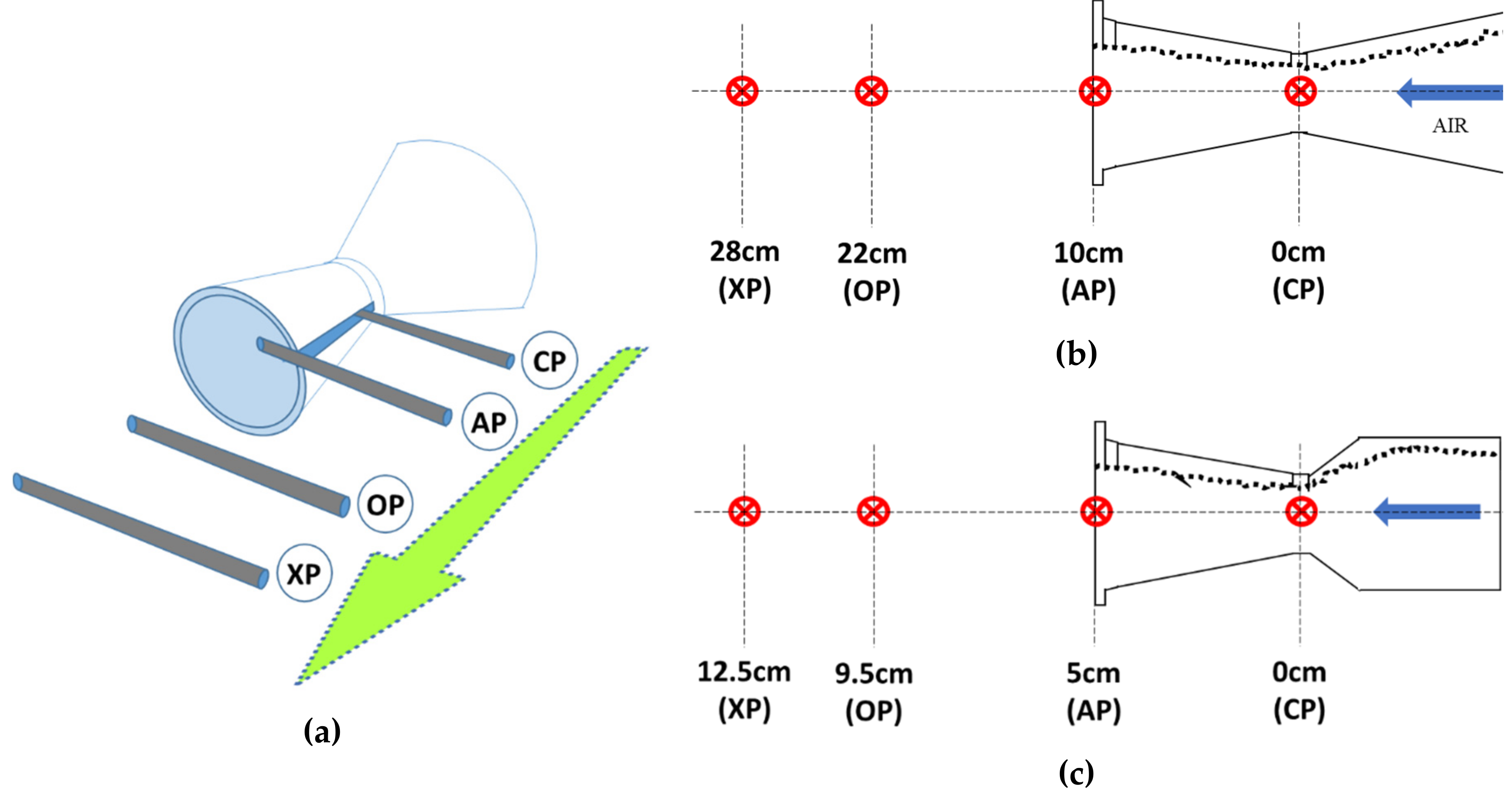
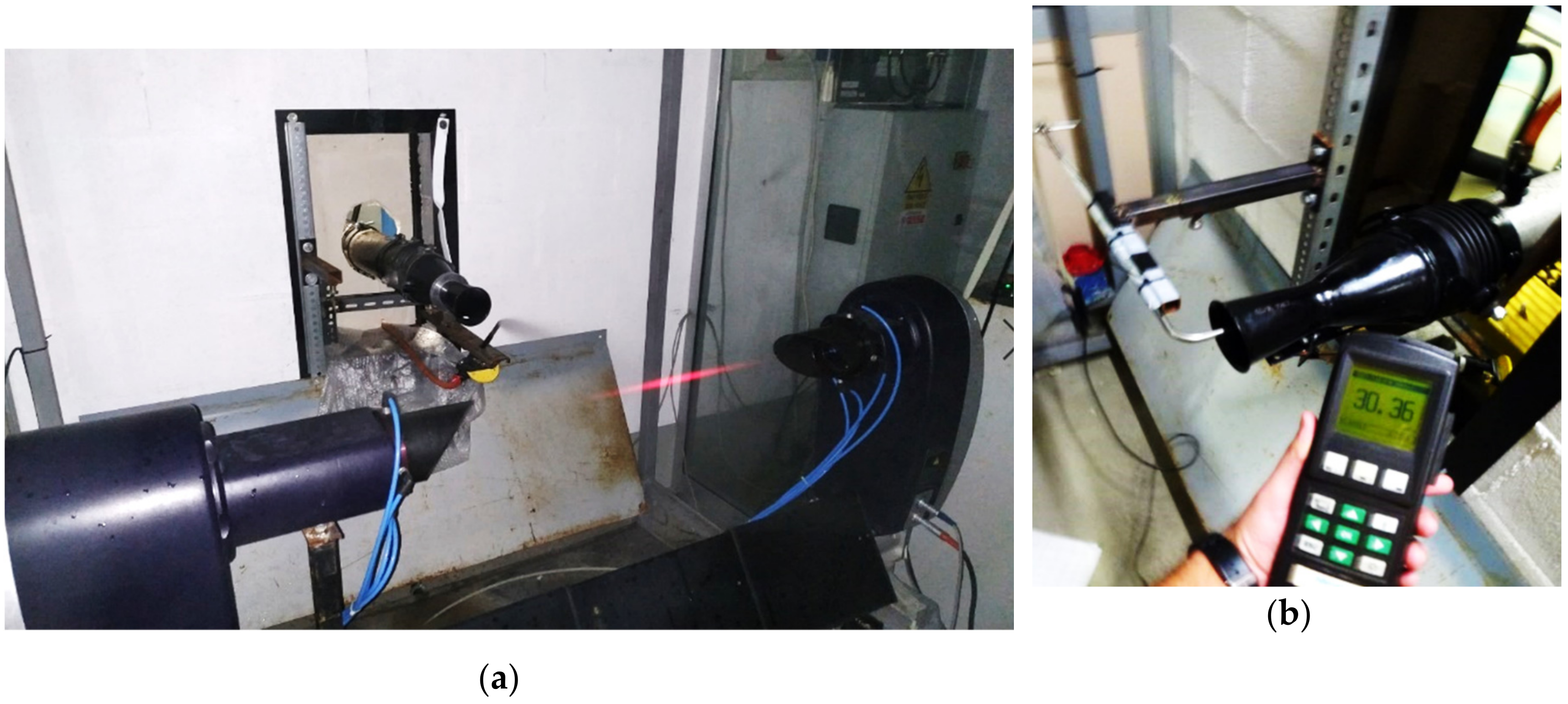
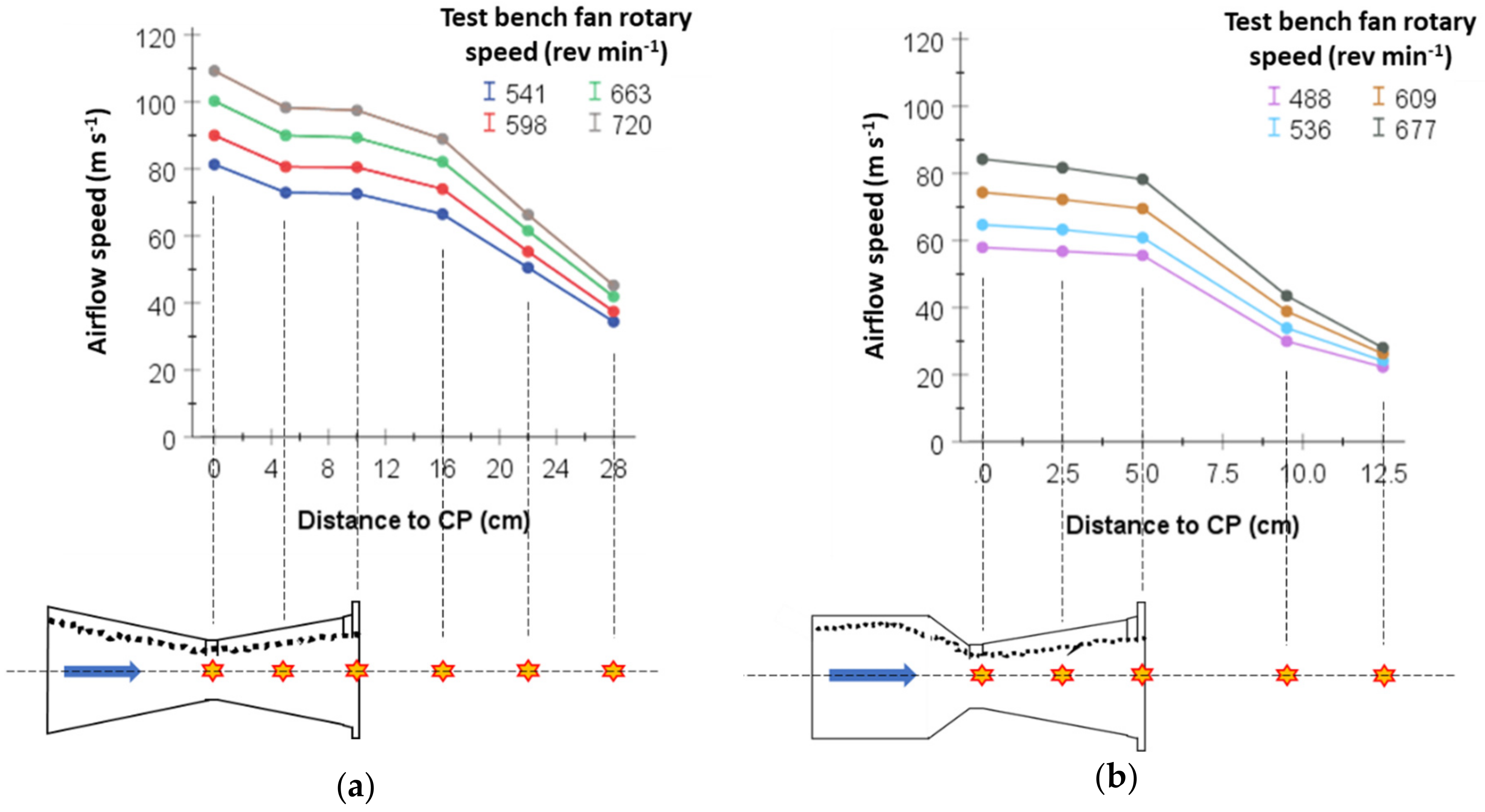

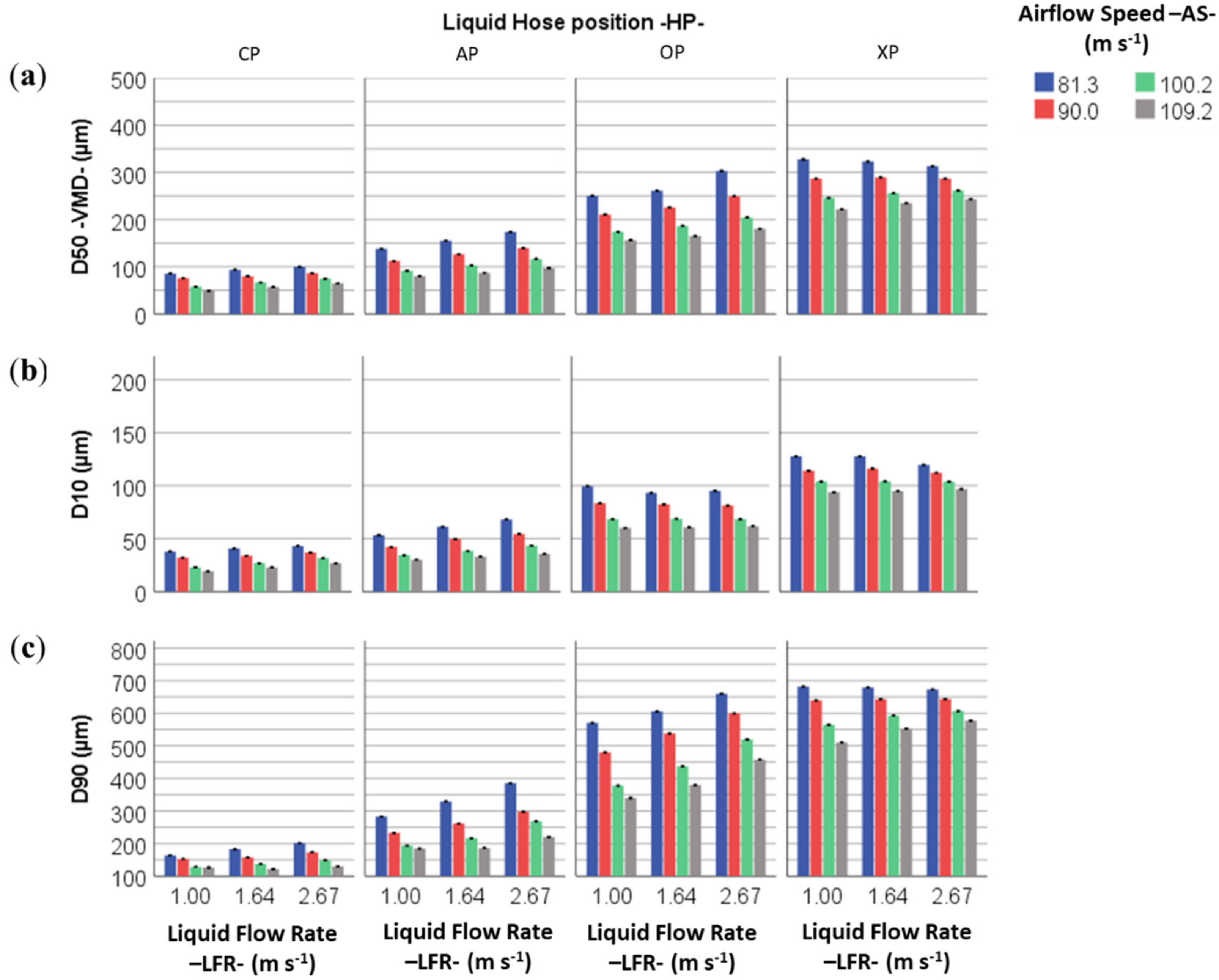
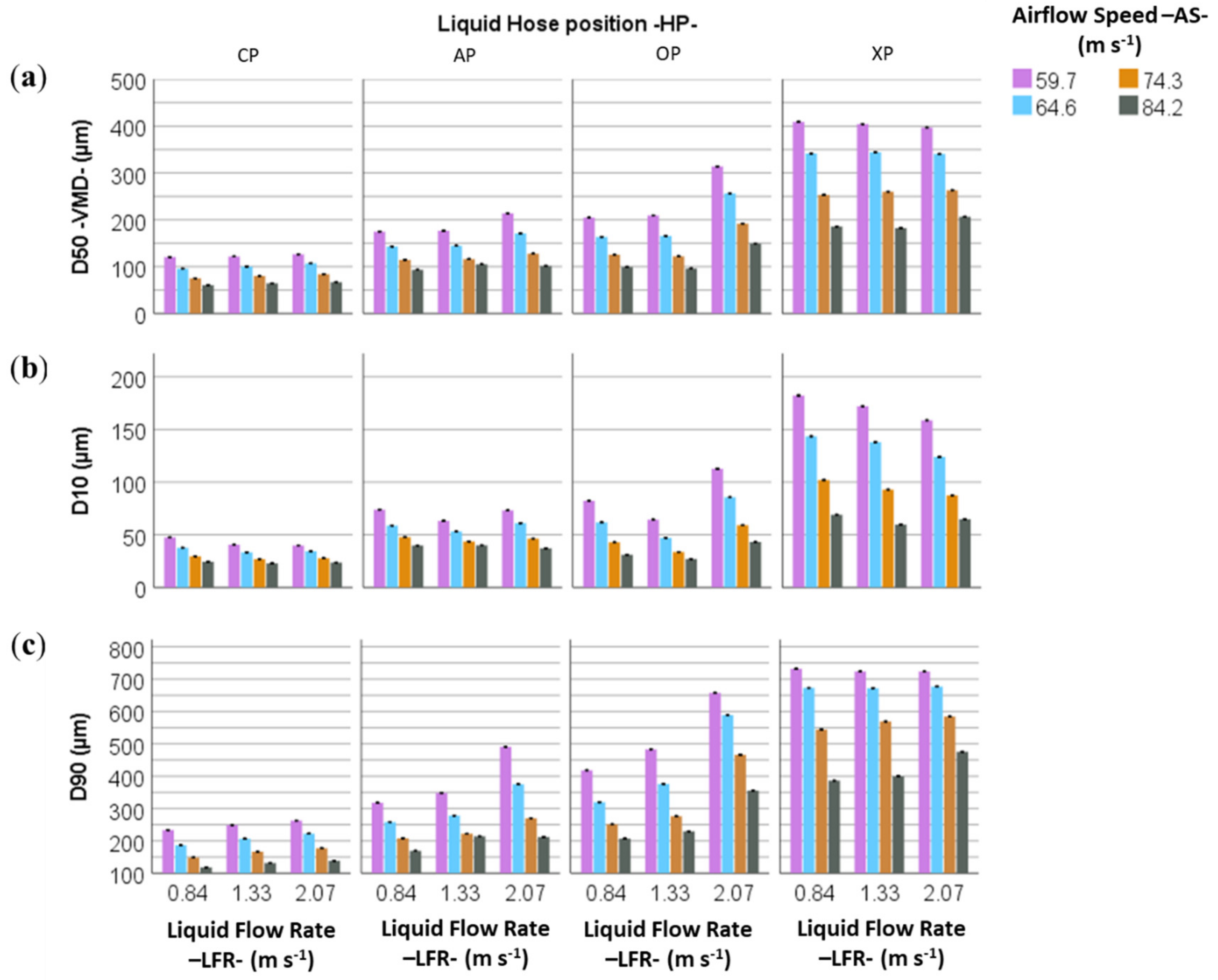

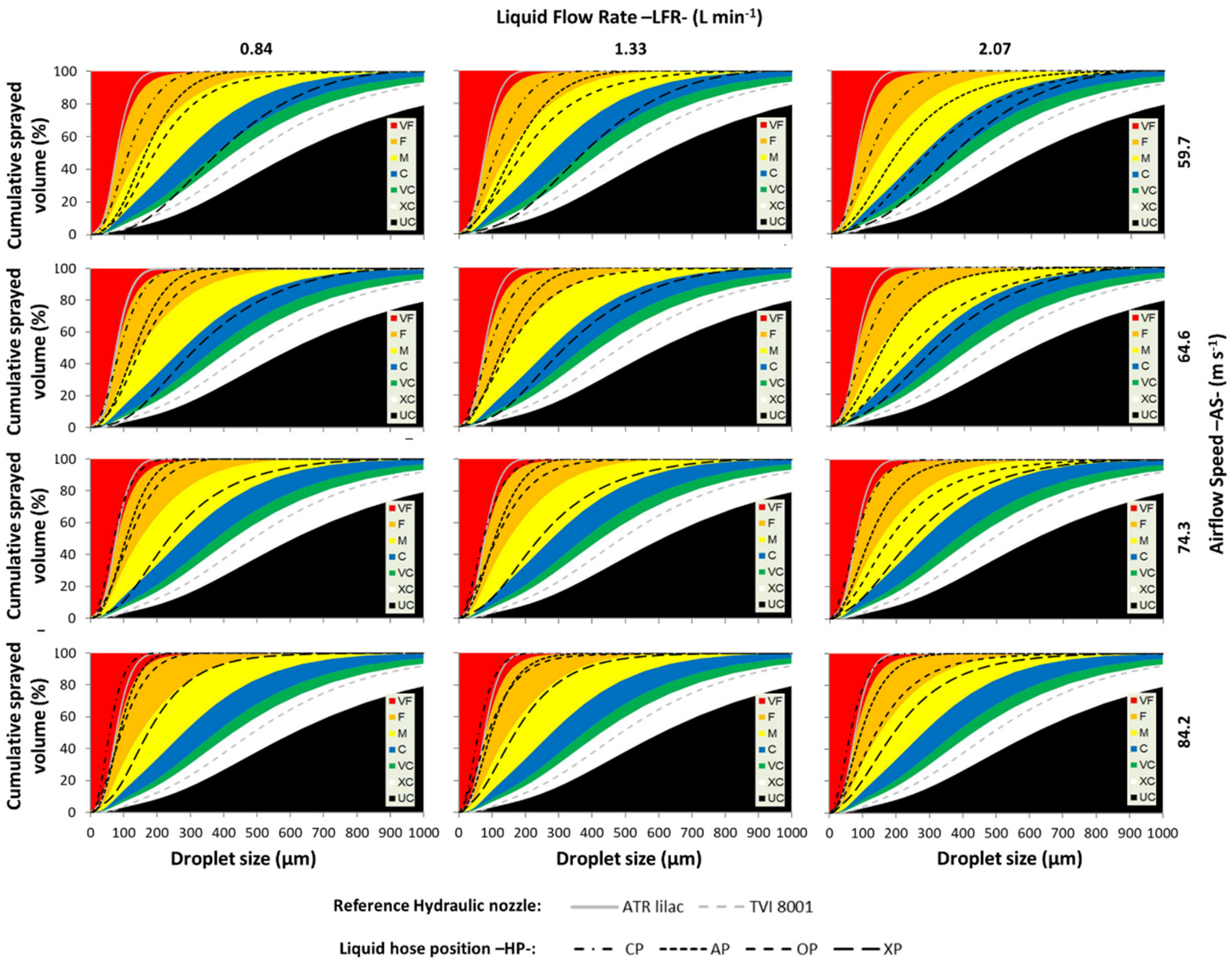

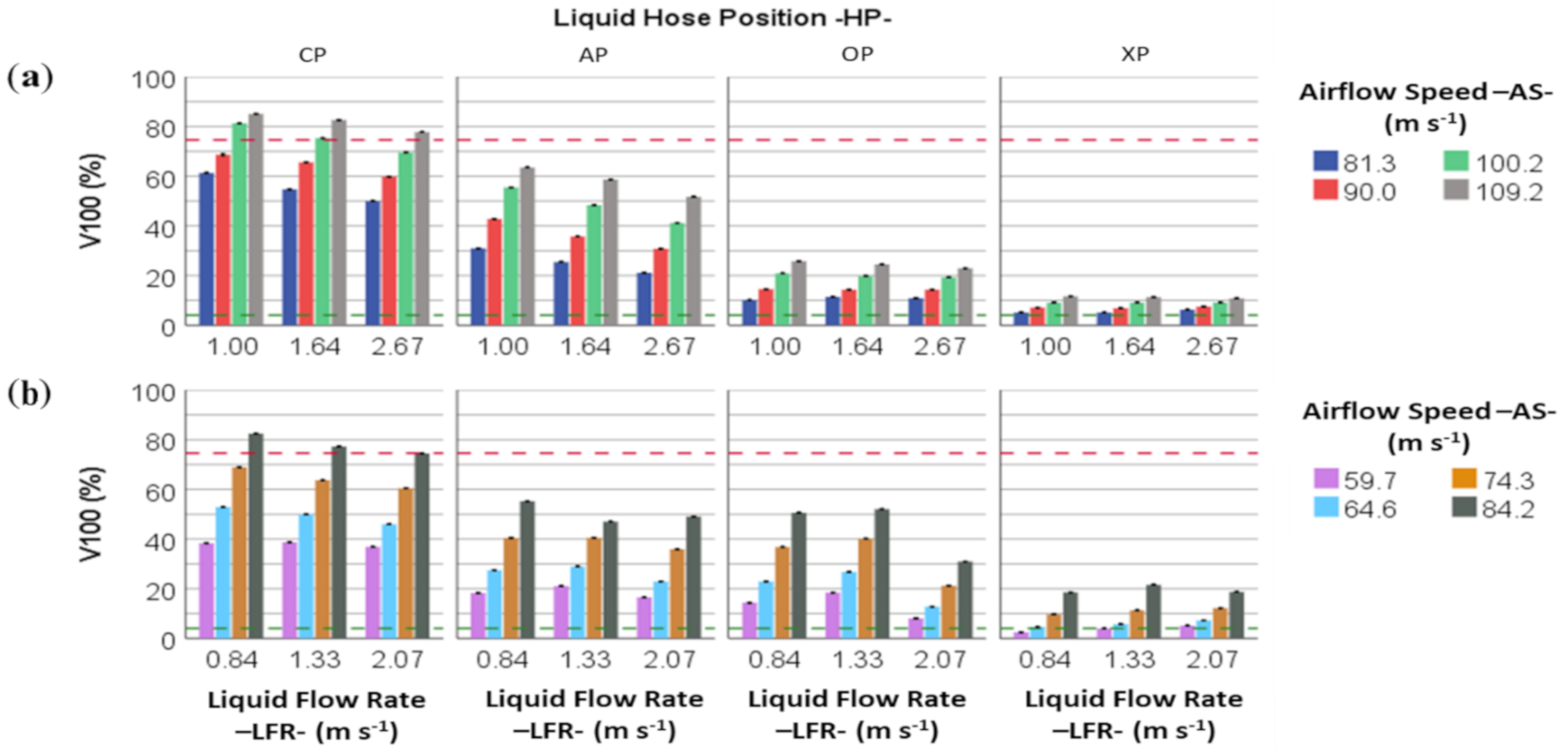

| Parameter * | Levels | Regulation Basis | Test Settings | |
|---|---|---|---|---|
| Cannon nozzle | LFR | 1.00/1.64/2.67 L min−1 | Flow regulator disc | Positions 3/5/7 |
| AS | 81.3/90.0/100.2/109.2 m s−1 | Fan rotary speed | 541/598/663/720 rev min−1 | |
| HP | 0/10/22/28 cm ** | Hose support | CP/AP/OP/XP *** | |
| Hand nozzle | LFR | 0.84/1.33/2.07 L min−1 | Flow regulator disc | Positions 3/5/7 |
| AS | 57.9/64.6/74.3/84.2 m s−1 | Fan rotary speed | 488/536/609/677 rev min−1 | |
| HP | 0/5/9.5/12.5 cm ** | Hose support | CP/AP/OP/XP *** |
Publisher’s Note: MDPI stays neutral with regard to jurisdictional claims in published maps and institutional affiliations. |
© 2020 by the authors. Licensee MDPI, Basel, Switzerland. This article is an open access article distributed under the terms and conditions of the Creative Commons Attribution (CC BY) license (http://creativecommons.org/licenses/by/4.0/).
Share and Cite
Grella, M.; Miranda-Fuentes, A.; Marucco, P.; Balsari, P.; Gioelli, F. Development of Drift-Reducing Spouts For Vineyard Pneumatic Sprayers: Measurement of Droplet Size Spectra Generated and Their Classification. Appl. Sci. 2020, 10, 7826. https://doi.org/10.3390/app10217826
Grella M, Miranda-Fuentes A, Marucco P, Balsari P, Gioelli F. Development of Drift-Reducing Spouts For Vineyard Pneumatic Sprayers: Measurement of Droplet Size Spectra Generated and Their Classification. Applied Sciences. 2020; 10(21):7826. https://doi.org/10.3390/app10217826
Chicago/Turabian StyleGrella, Marco, Antonio Miranda-Fuentes, Paolo Marucco, Paolo Balsari, and Fabrizio Gioelli. 2020. "Development of Drift-Reducing Spouts For Vineyard Pneumatic Sprayers: Measurement of Droplet Size Spectra Generated and Their Classification" Applied Sciences 10, no. 21: 7826. https://doi.org/10.3390/app10217826
APA StyleGrella, M., Miranda-Fuentes, A., Marucco, P., Balsari, P., & Gioelli, F. (2020). Development of Drift-Reducing Spouts For Vineyard Pneumatic Sprayers: Measurement of Droplet Size Spectra Generated and Their Classification. Applied Sciences, 10(21), 7826. https://doi.org/10.3390/app10217826








